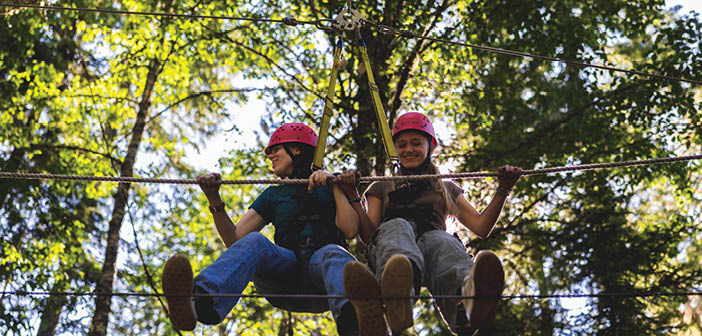When A.J. Edwards was 22 years old, his parents, Art and Jutta, dropped him off at the Mt. Hood Kiwanis Camp for a week-long overnight camp session. A.J. is mostly nonverbal, has cerebral palsy, seizure disorders, and is wheelchair-bound. In 22 years, A.J. had spent a total of two nights away from his family.
“It is extraordinarily rewarding to see the relief on the faces of families when they arrive at camp,” says Mt. Hood Kiwanis Camp (MHKC) executive director Dave McDonald. “They think they are getting a well-deserved vacation, but it turns into something more.”
Relief doesn’t exactly describe Art’s emotions as he drove back toward their home in Portland. All too aware of A.J.’s plethora of special needs, Art kept his phone nearby during his son’s week at camp, fully expecting the inevitable call requesting that he come collect his son.
The call never came.
A.J. communicates using a very limited vocabulary. When Art and Jutta picked him up six days later, they asked, “How was camp?” A.J. was quiet before blurting one word: “Fun!”
Art’s eyes fill with tears recounting the experience. A.J. is just one of thousands of campers who have attended MHKC.
A FORWARD-THINKING PROGRAM
Founded in 1934 by local service organizations to enable city kids to experience the outdoors on a 22-acre National Forest site on Mount Hood in northwest Oregon, MHKC shifted its focus in the 1950s to serving people with developmental and intellectual disabilities. Its mission: to empower those with disabilities through equitable access to the outdoors and recreation. The approach was forward-thinking at the time; in the ‘50s, most of this population lived in dismally overcrowded institutions with limited opportunity for recreation in, or interaction with, the natural world.

A camper enjoying the thrill of the flying squirrel.
Even now, many of the activities offered at the camp (high adventure course, zip line, whitewater, horseback riding, biking, hiking, canoeing, fishing, and more) aren’t typical fare for people with developmental and intellectual disabilities. “But why not?” asks McDonald, whose experiences at MHKC have taught him how significant the benefits of such activities are for his campers.
The high adventure course, with elements that include a flying squirrel, giant swing, climbing wall, a high cable stream-crossing, and a zip line that crosses the Little Zigzag River, is a highlight for many campers.
Synergo originally built the adventure course and inspects it annually. Synergo’s co-founder Erik Marter has a unique connection to MHKC: his mother for years served as program director, and Erik spent much of his childhood wandering and exploring camp and its surrounding forest. “The first element he ever built was a cable across a stream here,” says McDonald.
Accessibility. Adapting adventure course elements to the particular needs of MHKC campers—with rigid safety protocols for such activities—is straightforward compared to some of the challenges MHKC families face, says McDonald.
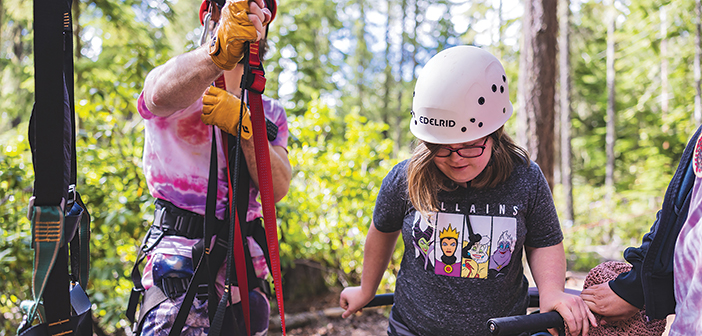
Specialized adaptive harnesses make every aerial activity accessible for all campers.
Adventure course staff overcome any challenges through training and using adaptive equipment. “It takes knowledgeable staff—and enough of them—to get someone out of a wheelchair and into an adaptive harness,” says McDonald, noting that they train for transfers, the use of adaptive equipment, as well as how to address specific needs that come with various disabilities. “There is so much institutional knowledge here,” he says of the nearly 20 full-time staffers.
Meanwhile, the camp is also equipped with tandem ride-along bicycles, adaptive horse-riding saddles, and canoes and kayaks that accommodate disabilities. “Our campers do things they simply wouldn’t have the opportunity to experience otherwise,” says McDonald. “It’s the most accessible camp of its kind that I’m aware of.”
BENEFICIARIES OF CAMP
Challenge course activities of any kind, including high ropes elements, expose participants to opportunities for personal growth and increased understanding. For the population of participants at Mt. Hood Kiwanis Camp, consider, too, that literally everything campers do—from simply being out in the forest and hearing running water in a mountain stream to pedaling a bicycle and swinging on the giant swing—is a new experience (or a once-a-year experience). “For many—no, most—campers,” says McDonald, “it’s the experience of a lifetime.”
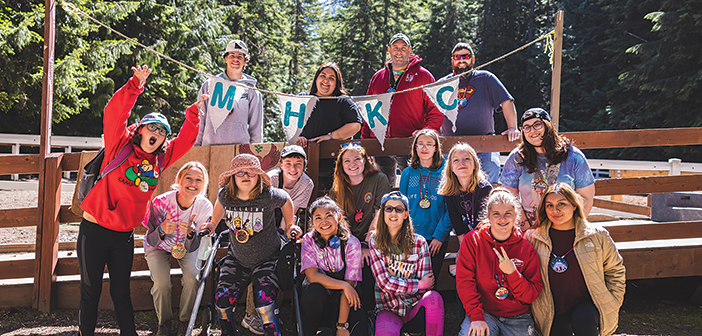
Campers and counselors gather daily in front of the stage to sing camp songs, perform karaoke, and show-off skits.
Campers aren’t the only beneficiaries: almost everyone connected with the program experiences positive growth. Families of people with developmental and intellectual disabilities face tremendous challenges and shoulder incredible burdens. “It’s very difficult for these families,” says McDonald. MHKC provides necessary respite for those families, while also ensuring their loved ones are having incredible experiences in caring hands.
Staffing with students. Speaking of those caring hands: aside from the small number of paid full-time staffers, the majority of the camp’s counselors come from Portland State University through a capstone program (participation in a community service capstone program is a graduation requirement at PSU) in which students earn six credit hours for two weeks of day-and-night service as counselors at MHKC. “Five thousand students have gone through this experience over the years,” says McDonald. Generally paired with one camper, these students often find the experience transformative.
“Many of them fall in love with our mission,” he says. Sometimes, student counselors change career paths as a result of the experience. For example, an education major might pivot to focus on special education. Frequently, the student counselors return another summer to work at camp again. MHKC also has arrangements with Pacific University at Forest Grove, the University of Oregon, and Oregon State, and these partnerships are win-wins: The student labor is critical for the camp’s operation, and the college students, initially fulfilling a hoop for graduation, find themselves reprioritizing what’s important in their own lives.
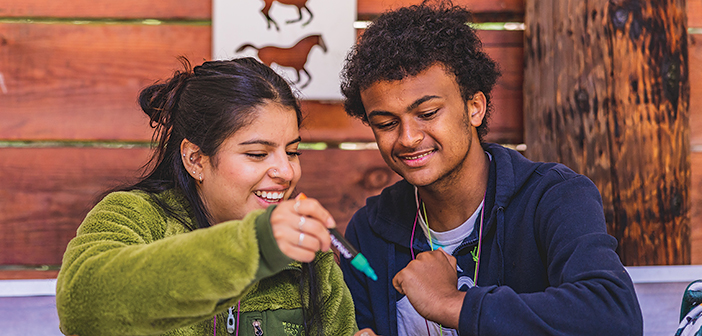
A camper (right) works on an art project with his counselor. MHKC provides a one-to-one camper-to-counselor ratio in addition to activity facilitators.
Even McDonald himself reevaluated when he gained an understanding of exactly what goes on at MHKC. After retiring from a career in broadcast radio station management that spanned businesses up and down the West Coast, McDonald correctly assumed some of his skills in sales, marketing, business, and finance would translate well in guiding a 501(c)(3) nonprofit.
He came to MHKC with little knowledge about ropes courses, camps, or disabilities, taking the vacant executive director position in an effort to help out. However, an aspect of his job unexpectedly blindsided him: “I got to know the community with which we work,” he says, a community to which he has fully committed since.
PEOPLE AND MATH
Mt. Hood Kiwanis Camp faces challenges—and they are far more complex than transferring campers from wheelchairs to canoes or guiding campers up climbing walls and other elements. To simplify, the difficulties boil down to people and math.
In an ideal world, MHKC is limited by the number of beds at its facility and, in a normal year, serves 500 campers. (If there was money for capital improvements, the camp would build more buildings.) Fortunately—and unfortunately—demand is there; far more potential campers attempt to register than MHKC can accommodate. “It breaks your heart to turn anyone away,” says McDonald.
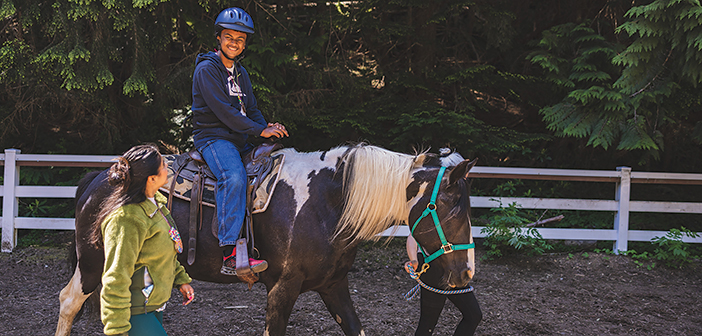
All activities are adapted to the individual abilities of each camper. MHKC has an adaptive saddle that supports fully independent participation at the horse corral.
The camp charges $230.75 per day—exactly the daily stipend that Medicare provides families for respite care.
The crux: at full capacity, revenues cover only half of camp’s expenses. Donations and off-season rentals (like clubs, family reunions, weddings, youth retreats, and so forth) bring in the rest of the revenue to cover facility operations—barely.
Staffing shortfalls. “Staffing is the most existential threat to our program,” says McDonald. Because working with this particular population requires a one-to-one staff-to-camper ratio, the labor-intensive aspect of the program makes it very difficult to staff—even with the college connections.
“During the pandemic, everything was put on hold because PSU wasn’t having in-person learning,” says McDonald. With no student staffers, MHKC didn’t offer summer camp programs in 2020, and it has yet to return to full capacity due to staffing shortfalls.

Adventure course facilitator Spencer Lamb (right) prepares a camper for a trip into the trees on one of the camp’s high elements.
“The only silver lining of 2020 was that we were able to work on some capital projects with nobody here,” says McDonald.
Another silver lining: Employee Retention Tax Credits through the CARES Act, Personal Paycheck Protection funding, and funding from the American Rescue Plan Act saved MHKC by enabling the organization to retain all of its full-time staff. (For anyone disillusioned by news reporting of widespread fraud in connection to government Covid-relief programs, rest assured that, at least in this case, the funding found a deserving organization—and saved it.) If MHKC had had to let its full-timers go—McDonald shudders. “I don’t know how you would restart all this with new people,” he says.
With a glass-half-full attitude, the camp is moving full-steam toward summer 2023 with plans to operate with full enrollment. The reality, however: How will MHKC find the staffing to operate at this level? Operating camp at less than full capacity costs the same as operating at full—the only difference is that less revenue comes in.
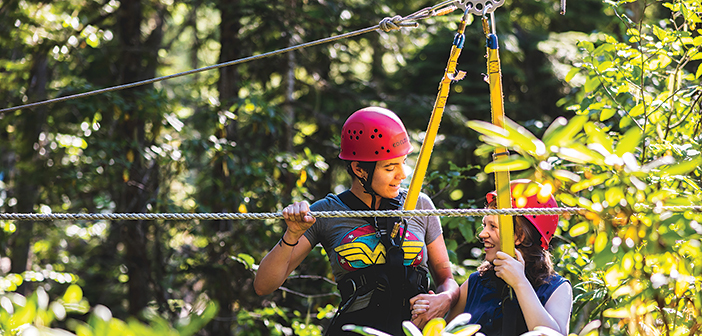
The stream crossing over the Little Zigzag River is another of MHKC’s exciting, at-height activities.
Meanwhile, capital projects like building maintenance, septic system upkeep, and other mundane yet essential (and costly) expenses continue to pile up—expenses that won’t go away even if camp is able to fill its spots.
An unsustainable model? A program like Mt. Hood Kiwanis Camp requires a few critical components. One is passion (of which there is plenty). Another is commitment, like the staffers who have internalized the program’s mission for decades. Another is funding. “The government has helped, the Forest Service has helped, and there are donations,” says McDonald. “But as it stands right now, it’s an unsustainable model.”
For McDonald and his team, it’s a year-round scramble to procure unrestricted funds necessary to fulfill the mission. Funding sources are individual gifts and donations, grants from charitable foundations, and fundraising events like a charity auction and a walking event. Donations come from individuals and corporations and range from $25 to $10,000 (“which would be a large gift for us,” notes McDonald).
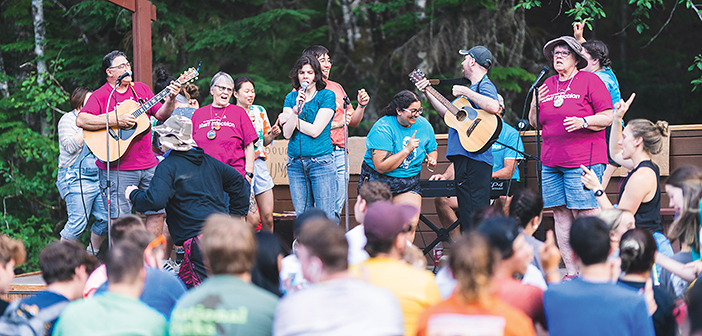
The Staff Infection Band” perform a song at the camp’s weekly BBQ event.
“Most grants are restricted for a specific use,” explains McDonald. “It is far easier to secure restricted grants than unrestricted funds.” For example, MHKC recently needed to replace a $100,000 front-loader—an indispensable tool for an organization located on Mount Hood, where it snows 300 inches per year. Half of the funding for the loader came from a grant and the other half from a private donor.
Although easier, McDonald notes that restricted grant funders generally don’t want to fund whole projects. “They prefer to see broader support,” he says. Also, funders tend to prefer providing the last dollars on a project—bringing it across the finish line—versus the first dollars. “Virtually every project requires multiple funders,” he says.
Despite real challenges, the rewards are plenty. “We do it for the campers and for their families—and we have campers who have been coming for 30 years,” says McDonald, noting the freedom that campers experience, the families who get much-needed respite, and the counselors doing life-changing work.
On the one hand, Mt. Hood Kiwanis Camp is a unique camp in a beautiful setting. But there’s more: “There is a real magic that breaks out here when camp is in session,” says McDonald, who hopes to help continue to unleash that magic for years to come.

In partnership with the U.S. Forest Service, MHKC has been serving kids and adults with developmental and intellectual disabilities since 1957.


